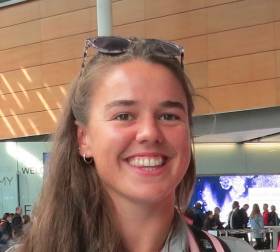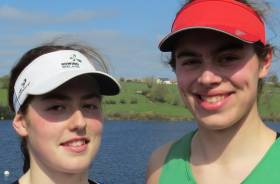Displaying items by tag: Ireland
#Rowing: Sanita Puspure won her heat of the single sculls at the World Rowing Championships in Linz with plenty to spare – and still set the second fastest time of the day. Laila Youssifou of the Netherlands took the second qualification spot for the quarter-finals, but she provided little challenge to the reigning champion, who was well clear. Puspure’s time of 7:44.41 was close to the 7:43.81 set by Emma Twigg of New Zealand in the fastest of eight heats.
World Rowing Championships, Linz, Austria, Day One (Irish interest)
Men
Pair – Heat One (First Four to Quarter-Finals; rest to Repechage): 6 Ireland (M O’Donovan, S O’Driscoll) 6:50.51.
Double Sculls – Heat One (First Three to Quarter-Finals; rest to Repechage): 1 Ireland (P Doyle, R Byrne) 6:28.93.
Lightweight Double Sculls – Heat Three (First Three to Quarter-Finals; rest to Repechage): 1 Ireland (F McCarthy, P O’Donovan) 6:28.02
Lightweight Single Sculls – Heat Four (First Three to Quarter-Finals; rest to Repechage): 4 Ireland (G O’Donovan) 8:06.49.
Women
Four – Heat One (First Two to A/B Semi-Finals; rest to Repechage): 3 Ireland (T Hanlon, E Lambe, A Keogh, E Hegarty) 6:44.72.
Pair – Heat Four (First Four to Quarter-Finals; rest to Repechage): 2 Ireland (A Crowley, M Dukarska) 7:13.30
Lightweight Double Sculls – Heat Four (First Four to Quarter-Finals; rest to Repechage): 4 Ireland (A Casey, D Walsh) 7:25.62.
Single Sculls – Heat Eight (First Four to Quarter-Finals; rest to Repechage): 1 Ireland (S Puspure) 7:44.41.
Lightweight Single Sculls – Heat Three (First Two to A/B Semi-Finals; rest to Repechage): 3 Ireland (L Heaphy) 8:01.79.
Impressive Heat Win by Doyle and Byrne at World Championships
#Rowing: Philip Doyle and Ronan Byrne are in top form and showed it by winning their heat of the double sculls at the World Rowing Championships in Linz today. They started well, swapped the lead with Australia in the middle stages, then took it over again in the final quarter. Belarus managed to take the third qualification place for the quarter-finals despite catching a crab coming up to the line. Their bow crossed just ahead of the United States.
World Rowing Championships, Linz, Austria, Day One (Irish interest)
Men
Pair – Heat One (First Four to Quarter-Finals; rest to Repechage): 6 Ireland (M O’Donovan, S O’Driscoll) 6:50.51.
Double Sculls – Heat One (First Three to Quarter-Finals; rest to Repechage): 1 Ireland (P Doyle, R Byrne) 6:28.93.
Lightweight Double Sculls – Heat Three (First Three to Quarter-Finals; rest to Repechage): 1 Ireland (F McCarthy, P O’Donovan) 6:28.02
Lightweight Single Sculls – Heat Four (First Three to Quarter-Finals; rest to Repechage): 4 Ireland (G O’Donovan) 8:06.49.
Women
Four – Heat One (First Two to A/B Semi-Finals; rest to Repechage): 3 Ireland (T Hanlon, E Lambe, A Keogh, E Hegarty) 6:44.72.
Pair – Heat Four (First Four to Quarter-Finals; rest to Repechage): 2 Ireland (A Crowley, M Dukarska) 7:13.30
Lightweight Double Sculls – Heat Four (First Four to Quarter-Finals; rest to Repechage): 4 Ireland (A Casey, D Walsh) 7:25.62.
Lightweight Single Sculls – Heat Three (First Two to A/B Semi-Finals; rest to Repechage): 3 Ireland (L Heaphy) 8:01.79.
Third Place in Heat for New Ireland Four at World Championships
#Rowing: The Ireland women’s four gave a good account of themselves on their first competitive outing together, just missing out on direct qualification from their heat of the World Rowing Championships in Linz, Austria.
Tara Hanlon, Eimear Lambe, Aifric Keogh and Emily Hegarty came up against Australia, who were dominant, and the United States, who overcame a poor start to take the second available semi-final spot. The Ireland crew pushed them right to line, with just 1.89 seconds between them at the finish.
World Rowing Championships, Linz, Austria, Day One (Irish interest)
Men
Pair – Heat One (First Four to Quarter-Finals; rest to Repechage): 6 Ireland (M O’Donovan, S O’Driscoll) 6:50.51.
Lightweight Double Sculls – Heat Three (First Three to Quarter-Finals; rest to Repechage): 1 Ireland (F McCarthy, P O’Donovan) 6:28.02
Women
Four – Heat One (First Two to A/B Semi-Finals; rest to Repechage): 3 Ireland (T Hanlon, E Lambe, A Keogh, E Hegarty) 6:44.72.
Pair – Heat Four (First Four to Quarter-Finals; rest to Repechage): 2 Ireland (A Crowley, M Dukarska) 7:13.30
Lightweight Double Sculls – Heat Four (First Four to Quarter-Finals; rest to Repechage): 4 Ireland (A Casey, D Walsh) 7:25.62.
Women's Pair Straight Through but O'Donovan and O'Driscoll Must Go Again at World Championships
#Rowing: Monika Dukarska and Aileen Crowley took an encouraging second place in their heat as they qualified for the quarter finals in the women’s pair at the World Rowing Championships in Linz, Austria. The United States looked to have the win wrapped up, but Ireland raced to the line and pushed them at the finish.
Mark O’Donovan and Shane O’Driscoll finished sixth in their heat of the men’s pair. They were not in the mix for the top-four placing which would have seen them directly into the quarter-finals, and must compete in a repechage.
World Rowing Championships, Linz, Austria, Day One (Irish interest)
Men
Pair – Heat One (First Four to Quarter-Finals; rest to Repechage):
6 Ireland (M O’Donovan, S O’Driscoll) 6:50.51.
Women
Pair – Heat Four (First Four to Quarter-Finals; rest to Repechage):
2 Ireland (A Crowley, M Dukarska) 7:13.30
Fifth for Ireland at World Junior Championships
#Rowing: Ireland’s Molly Curry and Rhiannon O’Donoghue finished fifth in the junior double at the World Rowing Junior Championships in Tokyo. The race was won by the outstanding Lisa Bruijnincx and Jacobien van Westreenen of the Netherlands. The Dutch pushed China into second. Behind them Germany lost out to Lithuania in the battle for bronze.
Curry and O’Donoghue initially fought it out with Greece for fifth. They won this battle and made up metres on Germany, but could not quite push into the battle for medals.
World Rowing Junior Championships, Tokyo, Day Five (Irish interest)
Men
Junior Four, coxed – A Final: 1 Germany 6:32.41, 2 South Africa 6:32.71, 3 China 6:33.90; 4 Ireland (J O’Donovan, M Gallagher, J Dorney, J Kearney; cox: L O’Regan) 6:34.82.
Women
Junior Double Sculls – A Final: 1 Netherlands 7:25.50, 2 China 7:27.66, 3 Lithuania 7:30.23; 5 Ireland (R O’Donoghue, M Curry) 7:38.08
Ireland Coxed Four Denied Bronze at World Junior Championships
#Rowing: Ireland’s junior men’s coxed four took fourth place at the World Junior Championships in Tokyo this morning.
The Ireland crew of James O’Donovan, Matthew Gallagher, Jack Dorney, John Kearney and cox Leah O’Regan came in just under a second short of the bronze medal slot.
Germany judged the race best of all. China, Ireland and South Africa were the top crews to the 1,000 metres, with China taking over a slim lead from their two rivals. Even as the Chinese tried to extend their advantage, Germany closed on all three crews. They produced a remarkable final 500 metres to sweep into the lead. South Africa took the silver and China just held out to take the bronze.
World Rowing Junior Championships, Tokyo (Irish interest)
Men
Junior Four, coxed – A Final: 1 Germany 6:32.41, 2 South Africa 6:32.71, 3 China 6:33.90; 4 Ireland (J O’Donovan, M Gallagher, J Dorney, J Kearney; cox: L O’Regan) 6:34.82.
Ireland's Curry and O'Donoghue Qualify for A Final in Tokyo
#Rowing: Ireland’s Rhiannon O’Donoghue and Molly Curry will compete in the A Final of the junior double sculls at the the World Junior Championships in Tokyo on Sunday. The Ireland crew took a clear third place in their semi-final this morning.
The Netherlands were impressive winners, while Lithuania raced well to take second. Ireland pulled clear of Belgium to sit in a qualification spot at 1500 metres. Italy pushed hard coming to the line, but they could not overhaul the Killorglin and Coleraine Grammar School girls.
China were the best crew in the first semi-final and look to the be the key challengers to Lisa Bruijnincx and Jacobien van Westreenen of the Netherlands. Germany were second to China and Greece won a contest with Britain to take third.
World Rowing Junior Championships, Day Four (Irish interest):
Women
Junior Double – Semi-Final Two (First Three to A Final; rest to B Final): 1 Netherlands 7:06.94, 2 Lithuania 7:12.66, 3 Ireland (R O’Donoghue, M Curry) 7:13.46; 4 Italy 7:15.71.
Semi-Final One: 1 China 7:09.41, 2 Germany 7:12.26, 3 Greece 7:14.12.
#Rowing: Ireland’s Molly Curry and Rhiannon O’Donoghue won their repechage and qualified for the A/B semi-finals at the World Junior Championships in Tokyo.
The Ireland junior women’s double overhauled Hungary in an impressive move. With 300 metres to go they were down; they drew level at 1750 and then motored clear to win by just over a length.
Ireland’s junior men’s coxed four had earlier qualified for their A Final by taking second in their heat.
World Rowing Junior Championships, Day Two (Irish interest)
Men
Junior Four, coxed – Heat One (First Two to A Final; rest to Repechage): 1 China 6:18.13, 2 Ireland (J O’Donovan, M Gallagher, J Dorney, J Kearney; cox: L O’Regan) 6:18.29; 3 South Africa 6:18.87.
Women
Junior Double Sculls – Repechage One (First Two to A/B Semi-Finals; rest to C/D Semi-Finals): 1 Ireland (R O’Donoghue, M Curry) 7:10.06, 2 Hungary 7:13.17.
Ireland Finish With Sprint to Take A Final Place in Tokyo
#Rowing: The junior men’s coxed four gave Ireland its first A finalist at the World Junior Championships this morning. In a thrilling finish to their heat, they took the second qualifying spot behind China.
Three boats had charged for the line, covered by less than a second. China had held a small lead over Ireland through half way and managed to stay just ahead despite a good charge by the crew of James O’Donovan, Matt Gallagher, Jack Dorney, John Kearney and cox Leah O’Regan. South Africa closed on both, but missed out.
World Rowing Junior Championships, Day Two (Irish interest)
Men
Junior Four, coxed – Heat One (First Two to A Final; rest to Repechage): 1 China 6:18.13, 2 Ireland (J O’Donovan, M Gallagher, J Dorney, J Kearney; cox: L O’Regan) 6:18.29; 3 South Africa 6:18.87.
#Rowing: Ireland’s Molly Curry and Rhiannon O’Donoghue finished second in their heat of the junior double sculls at the World Junior Championships in Tokyo this morning.
There was just one direct qualification spot for the A/B Semi-Finals, and the Netherlands were outstanding winners of this race. Lisa Bruijnincx and Jacobien van Westreenen made strong claims for being the best crew in this class with a big win.
Curry and O’Donoghue fought an exciting battle with Italy in the second half and won this by a length and a third. Greece, China and Belgium were the other heat winners.
Because of a worry about adverse weather, racing was run at five minute intervals, which brought forward the time of this heat.
World Rowing Junior Championships, Tokyo, Day One (Irish interest)
Women
Junior Double Sculls – Heat Four (Winner to A/B Semi-Final; rest to Repechages): 1 Netherlands 7:08.18; 2 Ireland (R O’Donoghue, M Curry) 7:16.55, 3 Italy 7:19.59.



























































